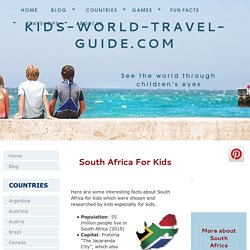

Africa Access Review. Final+Google+Earth+Tour. AFRICA+Unit+Intro. Africa%20Introduction. Africa Unit: Basic Facts About Africa. September 7, 2012 at 5:08 am , by Liesl Den As I’ve mentioned before, we are studying World Cultures this year and are starting with Africa.

Last week we started with some basic facts and the geography of Africa. We’re using a really terrific basic textbook on Africa that has lots of pictures and is wonderful for the ages of my kids. The first few days we worked through this Africa Learning Packet I created that was loosely related to the readings we did. So while the map below has the Sudan as part of North Africa, we did not include it in the sheets below because our text has the Sudan as part of East Africa. The kids were really blown away by the true size of Africa. Download the Africa Learning Packet: We used the flags of Africa from Montessori Materials to create country pins for our pin map (African Flags-page 1; African Flags-page 2). And for a couple of days while I read aloud the kids colored in some of the north African flags.
Other related posts you might find of interest: Africa - Africa Unit Plan. Contributed by MarilynNote: most suitable for primary students, but can be modified African animals Brainstorm list of all the animals you think come from Africa and anything students know about them.

Write down everything even if you know it is incorrect. You will review this list the last day to see which information was correct. You can refer back to the list throughout the unit and answer any questions students may have had at the beginning. The list should be posted in the classroom where the students can see it. Students could dress up like their favorite African animal or wear native African costumes. Zaire Peanut Soup 1 cup peanut butter (smooth style) 2 cups chicken bouillon 1/4 cup chopped onions 1/4 cup chopped tomatoes red pepper (optional) Heat bouillon and peanut butter together in a pan slowly, stirring until the peanut butter is dissolved. Ghana Beans and Rice 2 cups rice 1 cup dried white or red kidney beans water salt to taste Preheat the oven to 350 degrees F. Connections ~ Africa Unit Studies, Lesson Plans, Lapbooks, Printables. <A HREF=" Widgets</A> A Is for Africa by Ifeoma Onyefulu African Savanna (One Small Square) by Donald M.

Silver Ashanti to Zulu: African Traditions by Margaret Musgrove Bringing the Rain to Kapiti Plain: A Nandi Tale by Gail E. Haley Count Your Way Through Africa by James Haskins Fire on the Mountain by Jane Kurtz Galimoto by Karen Lynn Williams Jambo Means Hello Swahili Alphabet Book by Muriel Feelings Lions at Lunchtime (Magic Tree House 11) by Mary Pope Osborne Mufaro's Beautiful Daughters by John Steptoe Pulling the Lion's Tail by Jane Kurtz A Story, A Story by Gail E. Haley The Storyteller's Beads by Jane Kurtz Tree of Life: The World of the African Baobab by Barbara Bash Trouble by Jane Kurtz The Village of Round and Square Houses by Ann Grifalconi Water Hole Waiting by Jane & Christopher Kurtz When Africa Was Home by Karen Lynn Williams Materials and information may be used for your own personal and school use.
Africa unit. Africa Unit Study. Africa Unit. Exploring Africa. The Exploring Africa!

Curriculum is divided into Units, Modules, and Learning Activities. Each unit covers a major topic or theme in the study of Africa. Each unit is divided into thematic, disciplinary, regional, or country modules. Each module is comprised of four to eight learning activities. The learning activities in each module vary in length of time needed for completion. Each module plan in our curricublum follows a carefully prepared format. Map of Curriculum. South Africa Facts and Pictures. South Africa for Kids. Here are some interesting facts about South Africa for kids which were chosen and researched by kids especially for kids.

Population: 55 million people live in South Africa (2015)Capital: Pretoria "The Jacaranda City", which also often is referred to as 'Tshwane' as the municipality changed name in 2007, has got 2.3 million inhabitants.Name: Republic of South Africa, RSA, ZA ("Zuid Afrika")Government: DemocracyLanguages: 11 official languages: isiZulu, Afrikaans, English, isiXhosa, siSwati, Sesotho, Xitsonga, Sepedi, isiNdebele, Setswana, TshivendaReligion: mainly Christians and Muslims, but also Jews and other faiths.Currency: 1 South African Rand (ZAR)= 100 CentsHistory: South Africa was led by Apartheid leaders until Nelson Mandela came free from prison and became the first democratically elected leader in South Africa in 1994.National Symbols: Protea (flower), Springbok (antelope) and others.
Click here.Climate: Various climatic regions. African Crafts for Kids. AFRICA. Just for Kids. Our Africa. African great lakes region. Aspects of Africa. Africa. Africa.